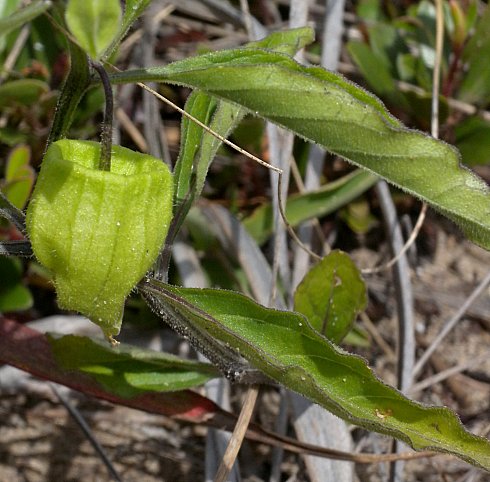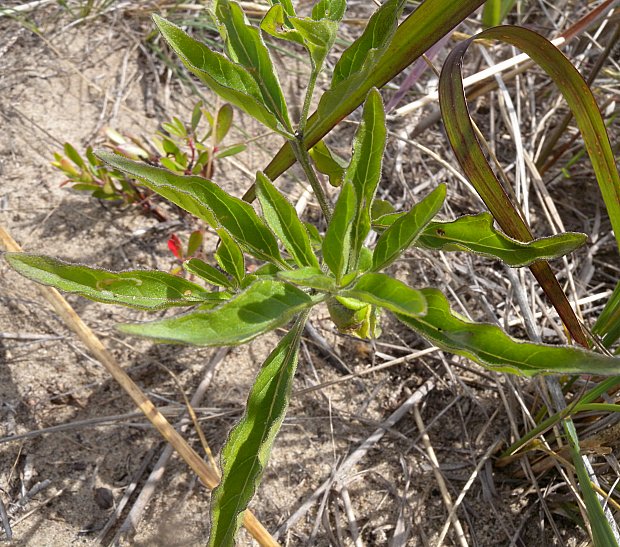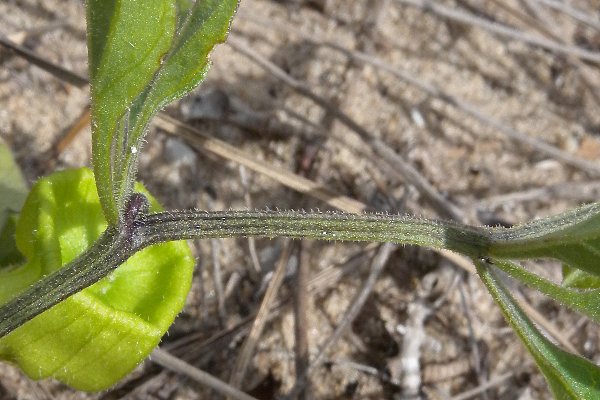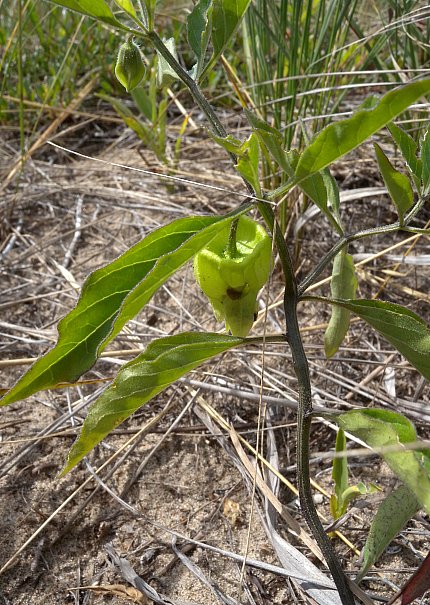
Each flower is ¾–1" when it is fully open, consisting of a light green calyx that is short-tubular with 5 triangular teeth, a short funnelform corolla that is pale yellow and shallowly 5-lobed, 5 inserted stamens with purple filaments and yellow anthers, and a pistil. The calyx is finely pubescent. The interior of the corolla has 5 conspicuous purplish blotches toward its base that are sometimes veiny. The slender pedicels are ½–1" long, light green to purplish green, and finely pubescent. The blooming period can occur from early summer to early autumn, lasting about 1½–3 months. Only a few flowers are in bloom at the same time. The flowers are replaced by nodding husked fruits; these husks are expanded calyces. The husks are 1–1½" long, ovoid to ovoid-conical in shape, slightly angular, and finely pubescent. Initially, they are light green, but at maturity the husks become light tan. Inside each husk, there is a single smooth globoid berry that becomes about 1/3" (8 mm.) across at maturity and orange-red. The interior of a mature berry is pulpy and slightly sweet; it contains several seeds. The small seeds are light tan and reniform (kidney-shaped). The root system is fibrous and rhizomatous. Sometimes clonal offsets develop from the rhizomes.

Cultivation: The preference is full to partial sun, mesic to dry conditions, and soil containing loam, clay-loam, sand, gravel, or rocky material. Overall, this ground cherry (Physalis sp.) is slightly less weedy than most species in this genus.
Range & Habitat: Virginia Ground Cherry is a native plant that occurs occasionally in most areas of Illinois, although it is more common in northern and west-central Illinois (see Distribution Map). This plant can be found in a variety of habitats, including upland rocky woodlands, upland sandy woodlands, upland savannas, open disturbed woodlands, rocky glades, hill prairies, disturbed areas of prairies, stabilized sand dunes, upper beach areas along Lake Michigan, gravelly or sandy areas along railroads, margins of cropland, abandoned fields, and barren waste areas. Virginia Ground Cherry prefers areas with a history of disturbance, although it does colonize higher quality natural areas where there is sparse vegetation.

Faunal Associations: The flowers are cross-pollinated by small bees, including plasterer bees (Colletes spp.) and Halictid bees (Robertson, 1929). Two plasterer bees, Colletes latitarsis and Colletes willistoni, and a dagger bee, Perdita halictoides, are specialist pollinators (oligoleges) of ground cherries (Physalis spp.). These bees suck nectar and collect pollen. Other insects feed destructively on the foliage, roots, flower buds, and fruits of Virginia Ground Cherry and other ground cherries. These insect feeders include the Potato Flea Beetle (Epitrix cucumeris), Tobacco Flea Beetle (Epitrix hirtipennis), another flea beetle (Epitrix humeralis), Three-lined Potato Beetle (Lema daturaphila), Three-lined Lema Beetle (Lema trivittata), larvae of two Sphinx moths, the Tobacco Hornworm (Manduca sexta) and Tomato Hornworm (Manduca quinquemaculata), larvae of two Gelechiid moths (Aristotelia physaliella, Symmetrischema lavernella), larvae of two Noctuid moths, the Subflexa Straw (Heliothis subflexa) and Tobacco Budworm (Heliothis virescens), larvae of the Eggplant Leafroller Moth (Lineodes integra), Solanum Mealybug (Phenacoccus solani), Solenopsis Mealybug (Phenacoccus solenopsis), and Potato Aphid (Macrosiphum euphorbiae). For more information, see Clark et al. (2004), Natural History Museum (2010), Wagner (2005), Needham et al. (1928), Pepper (1965), and ScaleNet (2014). Because the foliage of ground cherries is toxic and bitter, it is not eaten by mammalian herbivores. The berries of these plants, however, are sometimes consumed by such vertebrate animals as the Bobwhite Quail, Wild Turkey, Opossum, Striped Skunk, Spotted Skunk, Eastern Box Turtle, and Ornate Box Turtle (Martin et al., 1951/1961; Ernst et al., 1994). In consuming these berries, these animals help to spread the seeds to new locations.

Photographic Location: An upper beach area of Illinois Beach State Park in NE Illinois.
Comments: The various species in this genus can be difficult to distinguish. Virginia Ground Cherry (Physalis virginiana) is less pubescent than Clammy Ground Cherry (Physalis heterophylla), but more pubescent than Smooth Ground Cherry (Physalis subglabrata, Physalis longifolia). Another species, Dwarf Ground Cherry (Physalis pumila), differs from Virginia Ground Cherry by having branched or divided hairs along its stems, rather than simple hairs (use a 10x hand lens to see). In addition, Dwarf Ground Cherry has faded purplish blotches within the corolla of its flowers, rather than conspicuous purplish blotches. The nodding husks covering the berries of Virginia Ground Cherry are deeply sunken above, while those of many other ground cherries (Physalis spp.) are slightly sunken or rounded above. Similarly, the mature berries of Virginia Ground Berry are orange-red, while the mature berries of many other ground cherries are yellow.